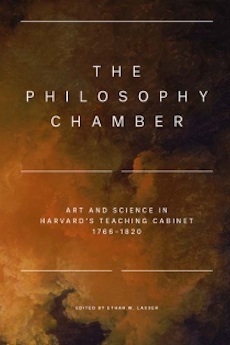By Svetlana Alpers
This elegantly designed, printed, and illustrated book (complete with a red ribbon to mark your place in the text) commemorates and seeks to explicate the ephemeral phenomenon of three exhibition rooms in Harvard Hall at Harvard College in place from 1766-1820. Published concurrent with an exhibition at the Harvard Art Museums, this book is fascinating to have, to hold, to read, and due to the splendid illustrations, to look at. One interest of the book is that the explication and assessment of the formation of knowledge through collected objects in the past reveals attitudes towards knowledge in the present. A subtext of the book seems to be that we now know better. While granting the curiosity of those living in time past, the writers here often see through them and it. The 18th century, while embracing the arts and the sciences, was aware of the unknown and so of the limits of knowledge. It would seem that scholars today are wary of claims to knowledge as such while being hugely sensitive to the often-misleading basis for the procedures to knowledge in the past.
The small 1,500 square foot room or chamber with two adjacent spaces called the Apparatus Chamber and the University Museum was the principle laboratory, lecture hall, and governing space of Harvard for a bit over fifty years. It was set up to bring together the disparate moral, political, and religious bases of Harvard at the Enlightenment moment when natural knowledge and arts were seen and treated as one. The collection of objects in it came together helter-skelter after a fire burned down the previous building. Unsolicited gifts came in from Harvard graduates and supporters worldwide. Though many written records remain, the researchers for this study were able to locate only two hundred objects or one-fifth of the original holdings. It is telling that while once they were assembled in adjacent spaces, now the survivors are scattered through many disciplinary entities at Harvard.
So what was there? Portraits of contemporary grandees, scientific instruments such as a magnificent orrery representing our solar system; scientific specimens like flattened fish mounted on paper; paintings of indigenous people and their brilliantly colored artifacts, which were trophies of exploratory voyages and colonial adventures; and a huge drawing of mysterious markings carved into a rock in the Taunton river, whose ancient or Indian roots were contentiously debated. Claims for and defense of a newly forming American identity were in play even as the nature of that identity was battled out with native Indians on the ground.
The inventive titles of book sections devoted to groups of objects in the Cabinet reveal the post-modern notion that the collection was about limits and loss. “Submergence,” “Smoke,” “Transposition,” “Flatness,” and “Decay” here have the force of metaphor. Submergence ranges widely from figurines in glass designed to react to changes in hydrostatic pressure, to the fact of the inaccessibility of ocean depths except by what are here described as enslaved or exploited native divers, to the Taunton tidal river inscribed rock. Smoke veers from the inscriptions in books to the painting of a volcano. Transposition is about scaling with a questioning account of the microscope. Flatness suggests the loss of materiality in objects under observation. Given the aesthetic beauty of this book itself, it is puzzling that the aesthetic beauty of the objects with which it is concerned is barely if ever noted.
There is an abiding sense here that putting something on exhibit in a collection is to kill the life of it in the world. The section on decay concludes with the surprising thought that “the objects that no longer survive may, in the end, be the ones that were allowed to live.” It is true that the Cabinet that is being memorialized disappeared leaving hardly a trace until the scholarly team behind this book got to work. But was that a historical circumstance internal to the nature of 18th century knowledge and inquiry? One might jokingly note that the Fogg Art Museum at Harvard has also recently disappeared.
In happy contradiction to this often bleak view, the final section of the book on the recent conservation of materials from the collection concludes with a celebration of Sewall, the man who managed against all odds to make a huge drawing of the Indian markings carved on the rock in the tidal river: “an exercise befitting the grandeur of the Philosophy Chamber and all that the room encompassed.”
That remark is rare in a book where scholar/authors share a deconstructive view of 18th and early 19th century knowledge. They repeatedly point to the limits of its frame, its forms of representation. Surely that is true of all forms of representation. This reader kept wondering on what ground these writers stand themselves? If the Harvard of the past (its professors, administrators, donors, visitors) was in error about the superiority of white over black and brown, and new America over old Europe, what are the blinders worn by the Harvard of today? The book makes one ask, because of the certainty with which the authors criticize the makers of an 18th century Philosophy Chamber…
Is offering to correct it the best way to understand the past?
Svetlana Alpers, an artist, critic, and renowned art historian, is professor emerita of the history of art at the University of California, Berkeley and a visiting scholar in the Department of Fine Arts at New York University.




